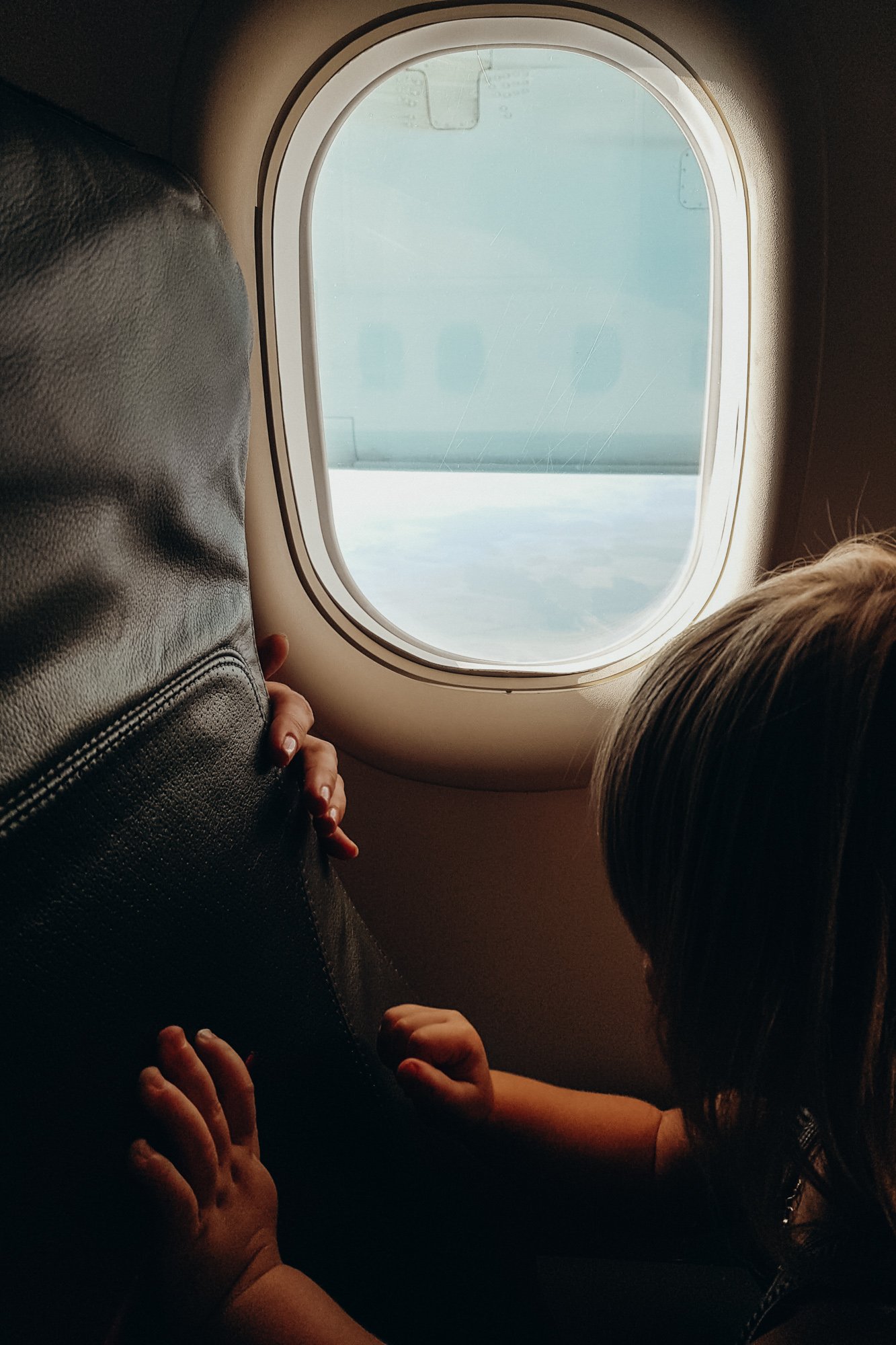Can We Fly Green? 8 Sustainable Air Travel Tips for Families
Can we springboard to a sustainable future for airlines? In the meantime, we share ideas and tips for families to bridge the difference.
In the battle to save the planet, air travel gets a bad rap. And rightly so. But does that mean we should limit travel to land or sea? As long as humans have inhabited the earth, we have migrated across its surface in pursuit of a better quality of life, of adventure, and of knowledge. Since the invention of the airplane over a hundred years ago, this search for new horizons has become more attainable for an ever wider demographic.
Along the way, we have learned that the carbon dioxide, contrails and other chemicals dumped during each flight cause irreparable damage to the environment— and to our fellow humans. One a long-haul flight generates more carbon emissions than the average person in dozens of countries around the world produces in a whole year. But we have also seen the positives of global trade and cultural exchange that air travel facilitated, and created a billion dollar tourism industry on which, according to the World Economic Forum, one in ten people in the world now depend for their livelihood. Last but not least, this cross-migration has given rise to the phenomenon of the global family, with parents, siblings, friends and loved ones spread out across the seven continents.
Traveling more slowly— taking alternative means of transportation, staying closer to home and traveling for longer period of time (if work and school allow)— has many benefits and rewards, but cutting out flying altogether at this point would be nearly impossible. So how do we change the way we see the world without shutting ourselves- and our children- off from the global economy, exposure to different cultural perspectives and, in many cases, our loved ones?
Here’s a good place to start—
The Facts
We think air travel, we think pollution, right? And it’s true. Most sources contribute 2-3% of global carbon emissions to the aviation industry. This may seem low compared to the roughly 30% attributed to the transportation industry at large, but if we don’t change the way we fly, this number is expected to more than triple by 2050. In fact, today, passenger numbers have actually increased by 3.3% worldwide in 2019 despite Greta Thunberg inspired the Flygskam (“flight shame”) movement across Europe and beyond.
“Things that sound too good to be true often are too good to be true. When we put carbon into the atmosphere it stays there for decades, hundreds, sometimes thousands of years – we can’t cancel that out with carbon offsetting. It’s a distraction from the real need, which is to reduce the amount of carbon we put into the atmosphere in the first place.”
Taking a road trip, a train ride or the ferry, whether you’re in San Francisco or Scandinavia, may seem like the obvious solution, especially if you have a toddler or two and not entirely thrilled about the prospect of being enclosed for countless hours in a vessel in the sky. But sometimes, especially for long distances, air travel is the most efficient.
Air Travel Innovations
While zero-emission flights are still a thing of the future, the industry is making strides in the right directions. With the innovation of Sustainable Aviation Fuels (SAFs) to hydro-electric planes, the process has already begun. Airlines both large and small are more and more committed to the environment.
easyJet hopes to run electric planes on shorter routes by 2030 and Norway aiming to make all short-haul flights electric by 2040. CEO & founder Val Miftakhov of hydrogen-electric ZeroAvia is pioneering a 250-mile zero emissions flight, roughly the equivalent of flying short haul. By 2030, the company aims to pilot single-aisle intercontinental hydrogen flights.
When it comes to plastic, airlines are starting to step up as well. HiFly flew it’s first single-use plastic free flight in 2018 and now runs all of its flights without single-use plastic. Ryanair has pledged to become plastic-free by 2023 and other airlines including Qantas and Air New Zealand are planning to significantly have plans to significantly reduce the amount of waste they send to landfill.
“The difference between the most efficient airline and least efficient is 26% of emissions.”
Beyond the airlines’ own messaging, the internet provides a wide array of independent resources to help travelers find the greenest carriers, calculate and compare emissions from potential flights and find out how to contribute to offsetting those emissions. Alternative Airlines searches the most environmentally friendly fleets and routes, Google Flights has an easy carbon metric when searching for flight options. Skyscanner prioritizes lower-emission flights with its “green choice” label. Skyscanner reported that more than 10 million travelers selected the lowest emissions flight for their route last year.
Greener Choice Booking Options
Check out Skyscanner’s “green choice” filter.
Google Flights displays CO₂ emission by weight and travelers can sort by that metric.
Try out Alternative Airlines for the most environmentally-friendly fleets and routes.
What Can We as Travelers Do?
In addition to avoiding planes when we can and supporting the most sustainable airlines when we can’t, there are many small ways we can lessen our impact when we fly.
Eliminate short haul flights from the itinerary.
Planes burn the most fuel during take-off and landing, so the fewer flights in one journey the better. For shorter legs, take the opportunity to slow down and soak in the surroundings from a train or bus window.
2. Fly coach.
Of course leg room and reclining seats make a long flight a lot easier, especially when traveling with kids, but all that extra space in business class have a much larger carbon footprint than their economy neighbors. According to a study by the Department for Business Energy & Industrial Strategy, up to four times larger per mile. Eek!
3. Pack light.
The lighter the cargo, the more efficient the plane, and from experience, makes the trip go so much more smoothly (plus, it’s better for mom’s shoulders). Changing our mindset around traveling with less can also be a good strategy for sustainable living back home.
4. Keep your Reusables handy.
Don’t forget to stash your utensils (except knives), bottles, napkins and all the things in your carry-on. This will make it easier to refuse single use plastics. Look out for refill stations, water fountains, or if in Europe, filling up in the good old bathroom is perfectly fine. Here’s a list of drinkable tap water across Europe by country. Also, normalizing the usage of reusables is so important for other families to see how it can be done. Who knew our Final Straws would be the object of every other kids’ desire?
5. Get Used to Saying “No Thank You”.
It’s a hard one, because we love to be polite and receive all the things, but by politely refusing things you don’t need- is a good way to set boundaries and set your kids up for good practice.
6. Opt for the veggie meal.
This won’t lower the emissions of the plane, but it offers one small way to offset your carbon footprint while in the air.
7. Offset, but don’t use it as a cure-all.
Carbon offsets are by no means a silver bullet, a solution to the multifold climate crises, or license to pollute. More of a band-aid than a cure-all, it still can never hurt to give back to the planet that gives us so much. Take time to look at offset programs that could align with you and your family’s values. Reforestation projects like Mossy Earth in the destination you’re visiting, tree-planting or forward-thinking innovations in carbon capture. Tomorrow’s Air offers a model that allows climate-positive travelers to remove CO2 from the atmosphere.
8. Stay curious, stay vocal.
Engage with airlines about their recycling program or biofuel options, the more pressure we as consumers put on the airlines to do better, the faster we can expect advances in technology and fleet renewal to take effect. And, as parents, if we normalize conversations around sustainability, we set a precedent for our kids to follow in our footsteps.
Despite the collateral havoc airplanes have wreaked on the environment, they still serve as the most accessible portal for us to explore the planet, educate our kids and support communities near and far. More than a necessary evil, our reliance on the aviation industry serves as a constant impetus for us to stay informed and use our voices and actions to defend the natural and cultural wonders of the world.
Made it this far?
Join our mailing list for regular updates about sustainable travel for you and your family.










